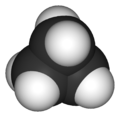Cyclopropane
Cyclopropane is the cycloalkane molecule with the formula C3H6, with three carbon atoms connected to each other in a ring structure, and each carbon atom being connected to two hydrogen atoms. The ring is very small, and ring strain can take place because of this.
| Cyclopropane[1] | |
|---|---|
Cyclopropane[2] | |
| Identifiers | |
| CAS number | |
| PubChem | |
| KEGG | D03627 |
| ChEBI | CHEBI:30365 |
| SMILES | C1CC1 |
| Properties | |
| Molecular formula | C3H6 |
| Molar mass | 42.08 g/mol |
| Appearance | Colorless gas |
| Odor | Sweet smelling |
| Density | 1.879 g/L (1 atm, 0 °C) |
| Melting point |
-128 °C, 145 K, -198 °F |
| Boiling point | |
| Acidity (pKa) | ~46 |
| -39.9·10−6 cm3/mol | |
| Hazards | |
| Main hazards | Highly flammable Asphyxiant |
| NFPA 704 |
|
| Except where noted otherwise, data are given for materials in their standard state (at 25 °C, 100 kPa) | |
Cyclopropane is an anesthetic, meaning inhaling large quantities of the gas form that evaporates can send somebody to sleep, however today, other chemicals are used by medical professionals. It is also very reactive, and can explode when mixed with oxygen.
Cyclopropane Media
References
- ↑ Merck Index, 11th Edition, 2755.
- ↑ Nomenclature of Organic Chemistry : IUPAC Recommendations and Preferred Names 2013 (Blue Book). Cambridge: The Royal Society of Chemistry. 2014. p. 137. doi:10.1039/9781849733069-FP001. ISBN 978-0-85404-182-4.





